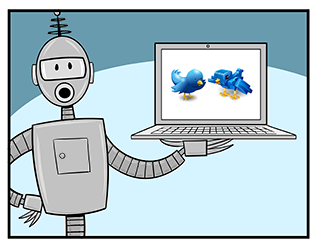Botometer

Elsewhere on this site, you have learned how you can use critical thinking and logic when investigating an account you suspect might be a bot. Your own analysis is an important part of this process, but there are also online tools such as Botometer that you can use to help you make a judgment.
Developed by the Indiana University Network Science Institute (IUNI) and the Center for Complex Networks and Systems Research (CNetS), Botometer examines the features of individual Twitter accounts and gives a score indicating the likelihood that they are a bot.
As computational scientist Stefan Wojcik notes, there is always a certain amount of uncertainty when making this sort of decision. However, he recommends looking at what the account is doing. “What kind of content is it sharing?” he asks. “Do the tweets convey human-sounding messages? What other accounts does it follow? Has the account tweeted every five minutes for its whole lifespan?” 1
To understand how it works, imagine that you were to enter your own Twitter account name into the system. Botometer would fetch your account’s public profile along with hundreds of public tweets and mentions. It would then examine this data closely, evaluating your account’s profile, friends, social network structure, activity patterns, language, and emotional sentiment. The system then uses “machine learning” to compare these characteristics to a data set containing tens of thousands of example. Ultimately, Botometer would deliver ‘bot score’ on a scale of 0 to 5. A rating of zero is “most human-like,” and a rating of fave is “most-bot-like.” 2
At the end of the day, you might be wondering if human beings are better at machines than identifying fake accounts. Professor Wojcik notes that it depends on the situation. “Some ‘obviously’ bot/human accounts according to a human observer will fool a machine learning algorithm,” he explains. “Likewise, an algorithm may confidently classify some accounts that humans have a hard time with. The best approach is to use this tool to complement, not to replace, your own judgment.” 3
References
1 John Gramlich (2018, April 19) “Q&A: How Pew Research Center identified bots on Twitter,” Pew Research Center.
2 The explanation in this paragraph is paraphrased from the Botometer documentation posted at: OSoMe (2018) “Botometer(R) by OSoMe,” Botometer.
3 John Gramlich (2018, April 19) “Q&A: How Pew Research Center identified bots on Twitter,” Pew Research Center.
